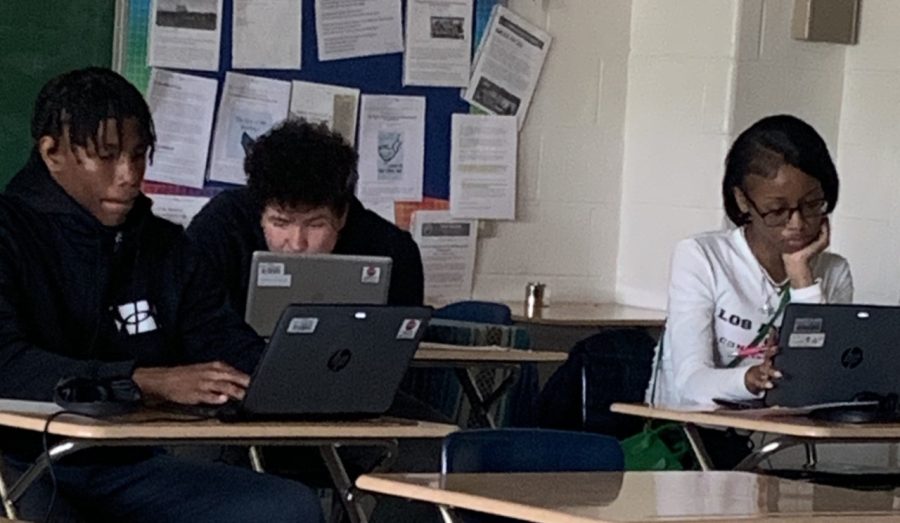Explosion of Testing at Schools This Spring: Measuring Student Success (And Creating a Booming Money Making Business)
Students often access their day to day lessons through educational technology rather than the old tradition of paper and pencils.
May 11, 2022
Here at Kenwood High and about every school across the country this Spring marks the return to standardized testing. Students and teachers are getting ready for everything from the SAT to AP testing for college and even IB testing here at Kenwood to Maryland state testing with MCAP.
With April and May filled with these exams it can feel overwhelming and stressful to students and teachers, and when those are finally over there are still end of the year final exams to go. Testing is often seen as a way to measure students’ growth and progress and has been seen as a way to hold teachers and schools accountable for the quality of education they provide students.
However, there have been many arguments over the years of this accuracy and necessity of measurement. Testing students seems to be a booming business for companies like McGraw-Hill, Pearson, and Houghton Mifflin. According to Education Week, studies show that states spend over $1.7 billion every year on standardized testing (Ujifusa).
Some see tests like AP and the SAT as a way to measure a student’s potential to succeed in college. The SAT is standardized test often required for some colleges as a part of the college admission process. For juniors they had the opportunity to take the SAT for free as an opportunity provided by Baltimore County Public Schools on April 26.
But the SAT was just one day of testing among weeks of expected testing. Many students at Kenwood are facing the overwhelming feeling of trying to prepare for the plethora of exams coming their way. Emerson Posadas said, “I handle my stress by taking it one day at a time and understanding what I can accomplish each day.”
In the beginning of May AP exams started taking place with students who take AP classes like AP History (APUSH), AP English , AP Math, and AP language classes, and many more rigorous courses like these.
Junior Genesis Bonilla is taking the AP English and AP History exam. Genesis said, “I don’t feel like I’m ready for the AP exams because of the transition back to in person learning, but regardless my teachers have been on track with preparing me for the test.” Many students feel out of touch with in person testing because of the virtual environment of the past two Springs.
Despite the many obstacles of this year, many teachers have been hard at work to prepare students for AP testing. Asharia Olukayode, a junior adds, “Mr. Mcwhorter gives us reviews for homework while we also have an AP History book that helps prepare us for the APUSH exam.”
Not only are students getting ready for AP testing but here in Kenwood’s IB program students like Mekhi Miller are getting ready for their IB exam. Mekhi said, “I feel prepared for the upcoming AP and IB exams because I’ve been studying and preparing for all the upcoming exams with guidance from my teachers.” Despite the stress testing brings, students feel confident in the upcoming test because they feel like they were prepared because their teachers provided plenty of guidance in the months leading up to the exam(s).
While the upper classmen tend to be taking AP and IB exams in preparation for college, the underclassmen are taking the Maryland state standardized test, the MCAP exam. Preparing and taking exams has been a common theme of school in Spring for teachers and students for decades now. As high school students, Kenwood students have experienced standardized testing since their elementary years. “A 2015 studies estimated that students would take 112 standardized test from K-12,” reports Miceala Warren out of Syracuse University.
State funding for schools is often connected to student testing. Again, some find this an inaccurate assessment and predictor of success. English teacher Glenn adds, “There are so many other ways to measure a student, teacher, and school’s growth and potential besides a test score. A test score doesn’t reflect a school or person’s character or work ethic-two things that are important indicators of success.”
With the “value of the testing market being anywhere from $400 million to $700” testing students doesn’t look to be something changing or going anywhere anytime soon but luckily our Kenwood teachers aim to do their best to prepare students for their Spring assessments. We wish all students testing this Spring the best of luck.
Sources:
Ujifusa, Andrew. “Standardized Testing Costs States $1.7 Billion a Year, Study Says.” Education Week. Updated 2022. Web Accessed 6 April 2022.
Warren, Micaela. “Standardized Tests expose privilege, not Intelligence”. The Daily Orange. Syracuse University. 9 February 2021. Web Accessed 6 April 2022.

